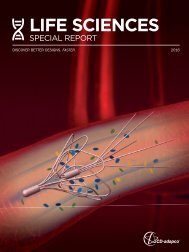Life Science Special Report December 2015
The Life Sciences Sector is experiencing an unprecedented change...
The Life Sciences Sector is experiencing an unprecedented change...
- No tags were found...
Create successful ePaper yourself
Turn your PDF publications into a flip-book with our unique Google optimized e-Paper software.
BLOOD FLOW SIMULATIONS LIFE SCIENCES<br />
BLOOD FLOW SIMULATIONS BRING<br />
SAFER AND AFFORDABLE<br />
HEMODIALYSIS TO THE MASSES<br />
PRASHANTH S. SHANKARA<br />
CD-adapco<br />
INTRODUCTION<br />
Chronic Kidney Disease (CKD) is an<br />
increasing public health issue affecting<br />
more than 8% of the global population.<br />
The most severe stage of CKD is End-<br />
Stage Renal Disease (ESRD) which is<br />
a total failure of the kidneys, requiring<br />
either dialysis or a kidney transplant for<br />
the patient to live. Statistics show that<br />
more than 50% of the patients suffering<br />
from ESRD do not meet the requirements<br />
for a transplant and hence depend<br />
on dialysis. An estimated two million<br />
people are currently receiving dialysis<br />
treatment worldwide. The majority of<br />
patients receiving this treatment are<br />
from fi ve countries (US, Japan, Germany,<br />
Brazil and Italy) with a major populace<br />
of patients from the rest of the world<br />
not receiving treatment due to a lack of<br />
access to dialysis and the unaffordable<br />
cost of this expensive procedure [1].<br />
Improved survival of patients on<br />
hemodialysis, coupled with the inability to<br />
provide enough renal transplants for the<br />
growing ESRD population, have resulted<br />
in an increase in the average time and<br />
number of patients on dialysis. When<br />
ESRD occurs, the kidneys cannot remove<br />
harmful substances from the blood.<br />
Hemodialysis removes the blood from the<br />
body and runs it through a special fi lter<br />
to eliminate the unwanted substances,<br />
and pumps the blood back into the body.<br />
The key requirement for hemodialysis<br />
is to draw the blood from inside the<br />
body. Access through a catheter is a<br />
short-term solution but longer-term, a<br />
connection between the arteries and<br />
the veins, known as an Arterio-Venous<br />
Fistulae (AVF) is established in the wrist<br />
or upper arm of the patients. When<br />
the AVF dilates, blood fl ow through<br />
it is increased substantially and this<br />
provides an access point to remove<br />
blood from the body for purifi cation.<br />
Complications associated with vascular<br />
FIGURE 1: A schematic illustration of an AVF in the arm, formed by<br />
anastomosing a vein onto an artery<br />
access and in particular the stability<br />
of AVFs is a major cause of morbidity<br />
among ESRD patients [1]. The patency<br />
of AVF is often severely reduced by the<br />
infl ammatory disease Intimal Hyperplasia<br />
(IH) and/or by thrombosis, causing<br />
unfavorable clinical outcomes, additional<br />
costs for healthcare systems and even<br />
death. AVF failures place a heavy cost<br />
burden on public-health systems,<br />
rendering such treatments expensive.<br />
These complications have established<br />
a need for a functional, durable and<br />
cost-effective vascular access. A team<br />
of researchers from Imperial College<br />
London are working towards using modern<br />
computational tools to develop novel AVF<br />
confi gurations with ‘favorable’ blood fl ow<br />
patterns, providing guidance to surgeons<br />
for dialysis treatments, and eventually<br />
making the procedure cheaper and less<br />
prone to failure due to IH. The team,<br />
consisting of researchers from Imperial<br />
College Renal and Transplant Centre, the<br />
Department of Medicine, the Department<br />
of Bioengineering and the Department<br />
of Aeronautics are collaborating with<br />
the Academic Health <strong>Science</strong> Centre<br />
and NIHR Comprehensive Biomedical<br />
Research Centre to use Computational<br />
Fluid Dynamics (CFD) to solve this<br />
internationally relevant healthcare problem.<br />
This article gives a brief overview of the<br />
research currently being undertaken<br />
at Imperial College London towards a<br />
safer, cost-effective dialysis procedure.<br />
ARTERIO-VENOUS FISTULAE<br />
AND THEIR FAILURE<br />
AVF are access points to the blood<br />
circulation for hemodialysis, created<br />
by a vascular surgeon using the<br />
patient’s native vessels. The vessels<br />
used - an artery and a vein -are joined<br />
(anastomosed) with the end of the vein<br />
SPECIAL REPORT<br />
19



